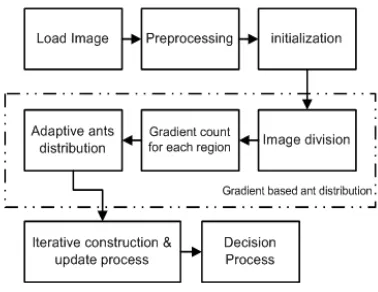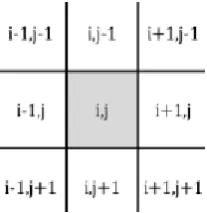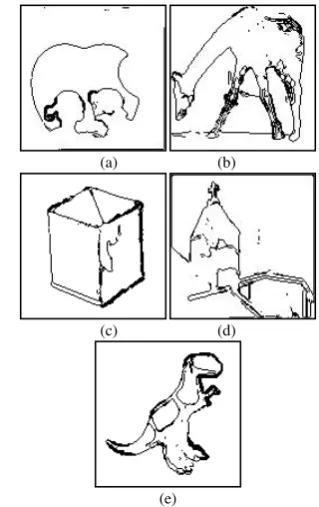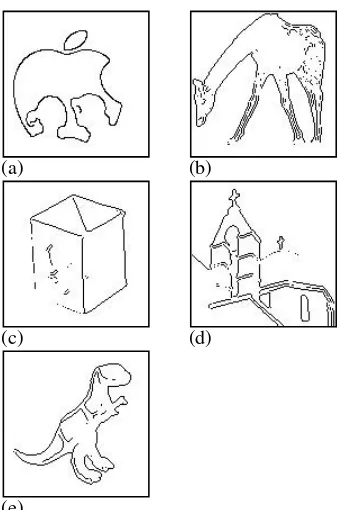DOI: http://dx.doi.org/10.21609/jiki.v7i2.260
ADAPTIVE ANT COLONY OPTIMIZATION BASED GRADIENT FOR EDGE DETECTION
Febri Liantoni, Kartika Candra Kirana, and Tri Hadiah Muliawati
Informatics Engineering, Faculty of Information Technology, Institut Teknologi Sepuluh Nopember, Jalan Raya ITS, Surabaya, 60111, Indonesia
E-mail: [email protected], [email protected], [email protected]
Abstract
Ant Colony Optimization (ACO) is a nature-inspired optimization algorithm which is motivated by ants foraging behavior. Due to its favorable advantages, ACO has been widely used to solve several NP-hard problems, including edge detection. Since ACO initially distributes ants at random, it may cause imbalance ant distribution which later affects path discovery process. In this paper an adaptive ACO is proposed to optimize edge detection by adaptively distributing ant according to gradient ana-lysis. Ants are adaptively distributed according to gradient ratio of each image regions. Region which has bigger gradient ratio, will have bigger number of ant distribution. Experiments are conducted using images from various datasets. Precision and recall are used to quantitatively evaluate perfor-mance of the proposed algorithm. Precision and recall of adaptive ACO reaches 76.98% and 96.8%. Whereas highest precision and recall for standard ACO are 69.74% and 74.85%. Experimental results show that the adaptive ACO outperforms standard ACO which randomly distributes ants.
Keywords: gradient, adaptive, random ant distribution, ant colony optimization
Abstrak
Ant Colony Optimization (ACO) merupakan algoritma optimasi yang terinspirasi oleh tingkah laku semut dalam mencari makan. Karena keunggulan yang dimilikinya, ACO banyak digunakan untuk menyelesaikan permasalahan non-polinomial yang sulit, salah satunya adalah deteksi tepi pada citra. Pada tahapan awal, ACO menyebarkan semut secara acak, hal ini dapat menyebabkan ketidak seim-bangan distribusi semut yang dapat mempengaruhi proses pencarian jalur. Paper ini mengusulkan algoritma adaptif ACO untuk mengoptimalkan deteksi tepi pada citra dengan cara menyebarkan se-mut awal secara adaptif berdasarkan analisis gradient. Sese-mut disebarkan berdasarkan perbandingan gradient dari tiap bagian citra. Bagian citra dengan perbandingan gradient yang lebih besar akan men-dapatkan pembagian semut yang lebih banyak dibandingkan bagian lainnya. Percobaan dilakukan pada beberapa citra yang berasal dari berbagai data set. Precision dan recall digunakan sebagai alat untuk mengukur citra keluaran algoritma yang diusulkan secara kuantitatif. Berdasarkan hasil uji co-ba, adaptif ACO mampu mencapai precision dan recall hingga 76.98 % dan 96.8 %. Sedangkan, nilai precision and recall tertinggi menggunakan ACO murni mencapai 69.74% dan 74.85%. Hasil ini me-nunjukkan bahwa adaptif ACO mampu menghasilkan citra keluaran yang lebih baik dibandingkan ACO murni yang sebaran semut awalnya dilakukan secara acak.
Kata Kunci: gradient, adaptif, sebaran semut acak, ant colony optimization
1. Introduction
Edge detection is process of extracting edge infor-mation from image. It is considered as fundamen-tal step used in most image processing applica-tions [1]. It is also a fundamental problem in ima-ge analysis. Edima-ges in an imaima-ge can be regarded as boundary between two different regions. An edge is easy to detect due topixel intensity difference between regions whichis relatively easy to calcu-late.
Many approaches have been proposed to ex-tract this image feature. Some commonly used methods are sobel, prewitt, and canny edge detec-tor [2]. Sobel edge detecdetec-tor uses local gradient
op-erators, which is able to detect edges that have a high spatial frequency and more specific orien-tation. Sobel edge detector produces poor results in blurred and noisy image. Prewitt operator pro-posed to extract the contour feature by installing the least-square error (LSE) squared surface for 3 * 3 picture window. Whereas, canny edge detector works in the multistage detector.
Recent works uses ACO to perform image edge detection. ACO is a nature-inspired optimi-zation algorithm which is motivated by ant for-aging behavior. Ant uses special chemical compo-und called pheromone to mark path between food source and their colony. Pheromone trails are used by subsequent ant as reference to find food since
Figure 1. Flow Mechanism of Adaptive ACO pheromone increases the likelihood of path to be
choosen.
Due to its favorable advantages, ACO has been widely used to solve several NP-hard pro-blems, which are Traveling Salesman Problem (TSP), Edge Detection, Network Packet Routing, Vehicular Routing, Quadratic Assignment Prob-lem, and so on. In this paper we are using ACO for edge detection purpose. Since ACO and edge detection are well-researched field, there exist ma-ny algorithms for detecting edges using ACO.
Agrawal et al. [3] implemented ant colony optimization for edge detection which was com-pared with Sobel and Canny edge detector. The result of proposed approach outperformed edge detection using Sobel and Canny.
Edge detection using ant colony system was proposed by Tian et al.[4]. They proposed formula to calculate the number of ants. This method gave superior result compared to ACO which impleme-nted ant system.
Verma and Sharma [1] presented edge detec-tion approach using ACO which was combined with universal law of gravity. Theory of universal gravity was implemented to calculate the heuristic function which lead ant towards the most pro-mising solution.
Fuzzy-ACO approach was proposed by Ver-ma et al.[2]. The number of ants was calculated and placed at end point of image edges filtered by Sobel edge detector. Fuzzy derivative technique implemented fuzzy probability factor to decide the next most probable pixel to be edge.
ACO can avoid premature convergence by way of distributed computing but it converges slo-wly [1]. Since initially ants are randomly distribu-ted, it may cause imbalance ant distribution which later affects path discovery process. Therefore, in this paper adaptive ACO is proposed to optimize ant distribution using gradient. The number of dis-tributed ant is adaptively adjusted based on the number of gradient within image regions.
2. Methods
Ant Colony Optimization
ACO is meta heuristic approach, where the first ACO algorithm, called antsystem, was proposed in by Dorigo et al. Afterwards, there are several ACO approaches that improve basic ACO algori-thm, which are Ant Colony System (ACS), Min-Max Ant System (MMAS), Elitist Ant System (EAS), Rank-Based Ant System (ASRank) and so on.
The main mechanism of ACO is the best pa-th discovery using ant’s pheromone updates. Each ant initially moves in random way to find the fo-od. After getting food, ant returns back to its colo-ny while laying down pheromone trails. Pheromo-ne trails are used to mark the path between a food
source and its colony. Afterwards, pheromone tra-ils are used as references for subsequent ants to find foods. Subsequent ants may follow the exis-ting path or create new path.
Pheromone may be evaporated over time. Thus, if there is no ant crosses the existing paths, those paths will soon dissappear. It also depends on time amount needed by ants to travel between nodes. In the other hand, if the existing paths are followed by ant, it may strengthen the pheromone trails on those paths.
Pheromone density remains high in shorter paths because pheromone set faster than evapora-tion. Since pheromone increases the likelihood of subsequent ants to choose the path, this mecha-nism leads ants to get better solution. In addition, ACO also uses heuristic information to help de-termining ant movement. It may be vary depends on the application. For instance pixel intensity is used as heuristic information in edge detection, whereas TSP uses distance between each node.
In this paper, instead of using Ant System, we prefer to use ACS algorithm. Since ACS has pseudorandom proportional rule to optimize ant’s movement. Pseudorandom proportional rule uses user defined threshold (𝑞𝑞0),whose value is betwe-en 0 to 1, to complembetwe-ent traditional random pro-portional rule. On each ant’s movement, it is nee-ded to randomly generate q whose value is distri-buted between 0 and 1. If q is greater than 𝑞𝑞0, then random proportional rule is used to decide ant’s movement. However, if q <𝑞𝑞0, ant should move according to transition that maximizesτijαηijβ. Ran-dom proportional rule is given in equation(1).
𝑃𝑃𝑖𝑖𝑖𝑖=
(𝜏𝜏𝑖𝑖𝑖𝑖)𝛼𝛼 (η𝑖𝑖𝑖𝑖)𝛽𝛽
𝛴𝛴𝑖𝑖𝑗𝑗𝑗𝑗𝑖𝑖 (𝜏𝜏𝑖𝑖𝑖𝑖)𝛼𝛼 (η𝑖𝑖𝑖𝑖)𝛽𝛽 𝑖𝑖𝑖𝑖𝑗𝑗𝜖𝜖𝛺𝛺𝑖𝑖 (1)
wei-2, June 2014
Do initialization procedures Do image division into 4 regions Do gradient count for each region Do ant distribution based on gradient ratio
Update visited pixels’ pheromones end
Figure 2. Pseudocode of Adaptive ACO
Figure 2. Pseudocode of Adaptive ACO ghting factor (α) and heuristic information
weigh-ting factor (β).
In addition, ACS has two pheromone update mechanisms, which are local pheromone update and global pheromone update. Local pheromone update is firstly introduced in ACS and cosidered as the most interesting contribution of ACS [4]. Formulas for local pheromone and global phero-mone updates are defined in equation(2) and equation(3).
𝜏𝜏𝑖𝑖𝑖𝑖= (1− 𝜑𝜑).𝜏𝜏𝑖𝑖𝑖𝑖+ 𝜑𝜑.𝜏𝜏0 (2)
𝜏𝜏𝑖𝑖𝑖𝑖= (1− 𝜌𝜌).𝜏𝜏𝑖𝑖𝑖𝑖+ 𝜌𝜌 .∆𝜏𝜏𝑖𝑖𝑖𝑖 (3)
Local pheromone update aims to diversify the search performed by subsequent ants during an iteration [5]. It is implemented by using phe-romone decay (φ) and phephe-romone init (𝜏𝜏0) to
de-crease the pheromone concentration on the traver-sed edges. Therefore subsequent ants can produce different solutions. Whereas pheromone evapora-tion rate (𝜌𝜌) and total deposit pheromone (∆𝜏𝜏𝑖𝑖𝑖𝑖) are used to implement global pheromone update. Adaptive ACO
In this paper, we proposed new approach to opti-mize ant distribution in ACO for edge detection. Standard ACO used to randomly generate ants and place it over the image. This may cause imba-lance ant distribution which later affects path dis-covery process.
Our proposed method intends to divide ima-ge into 4 equal regions anda adaptively distributes ants according to the number of potential edge within each region. Since edges are assumed to be high gradient pixel [6], proposed method uses gra-dient to forecast the ratio of potential edge within each region.Region which has bigger gradient va-lue will get bigger number for ant distribution. Therefore it can optimize path discovery process in ACO. Flow mechanism and pseudo code of
proposed method are presented in Figure 1 and Figure 2.
After being loaded, each image is converted to grayscale image and resized into user predefi-ned size. Initialization comprises defining value for ACO parameters, which are number of ants (K), construction step (L), iteration (N), pheromo-ne evaporation rate, and pheromopheromo-ne decay as well as the weighting factor for pheromone and heuris-tic information. K is taken from square root of im-age’s high and imim-age’s width multiplication [4]. Formula to determine the number of ants is pre-sented in equation(4).
𝐾𝐾= �𝑤𝑤𝑖𝑖𝑤𝑤𝑤𝑤ℎ ∗ ℎ𝑒𝑒𝑖𝑖𝑒𝑒ℎ𝑤𝑤 (4)
Heuristic information count and pheromone initialization are also conducted within this step. Pheromone init for each pixel is uniformly distri-buted between 0 and 1. Whereas, heuristic Infor-mation is derived from local variation of pixel in-tensity. Figure 3 presents configuration for com-puting local intensity variation of specific pixel.
Gradient based ant distribution covers mech-anism to distribute ants based on gradient value within each region. Image will be divided into 4 equal regions whose gradients are counted sepa-rately. The proposed approach uses prewitt opera-tor masks to count gradient value of each region as presented in Figure 4.
-1 0 1 -1 -1 -1
-1 0 1 0 0 0
-1 0 1 1 1 1
Figure 4. Convolution masks for counting gradient
Figure 58-connectivity neighborhood : Permissible range of ant movement
TABLE 1
ASYMMETRY DEGREE OF IMAGES
Image Gradient Ratio The Asymmetry Degree
Parameter Parameter Value
K 128 3. Results and Analysis
Series of experiments are conducted to evaluate the performance of the proposed method using fi-ve test images which are (1) apple logo, (2) gira-ffe, (3) box, (4) church, and (5) dinosaur. Test im-ages are taken from various image datasets. Apple logo and giraffe are taken from Brown Univer-sity’s image dataset [7]. Box and dinosaur belong to MIT Intrinsic images dataset [8]. Whereas chu-rch is Matlab image dataset [9]. Each image has different asymmetry degree which is presented in Table 1. As comparison, Figure 6 presents the pre-processed images with 128 x 128 resolution.
Previously, we had conducted several experi-ments to evaluate ACO parameter values which are not reported here. From those experiments, we have concluded that ACO parameter values are taken as presented in Table 2
Based on Table 3, standard ACO distributes ants randomly. However, adaptive ACO distribu-tes ants adaptively based on gradient analysis. For apple logo image, ant distribution in both standard and adaptive ACO do not show significant diffe-rence due to its low degree of asymmetry. On the contrary, church and dinosaur have high degree of ant distribution. Since both images have high asy-mmetry degree.
Adaptive ACO combines the theory of stan-dard ACO with Prewitt operator which is used for gradient calculation. Thus, we compare the result image among these three algorithms which are ad-aptive ACO, standard ACO, and Prewitt edge de-tector. In addition, we use the groundtruth image as standardization. Groundtruth of test images is provided in Figure 7. Whereas Figure 8, Figure 9, and Figure 10 present experimental results of
stan-dard ACO, adaptive ACO, and Prewitt edge de-tector.
Figure 7 is more similar with Figure 8 than Figure 9 and Figure 10. It means that adaptive ACO returns more similar image to groundtruth than standard ACO and Prewitt edge detector. Since ants are distributed according to each regi-on’s gradient, region which has bigger gradient value get bigger number for ant distribution. On the contrary, region with lower gradient value will get fewer ants. Therefore ants can effectively mo-ve and edges are easier to be detected. Howemo-ver, eventhough potential edges have been found, ants will continuously search through image. Unfortu-nately, this may lead to edge thickening.
In order to compare the quality of proposed method, we quantitatively evaluate the performan-ce using precision and recall. Precision or positive predictive value is the fraction of retrieved instan-ces that are relevant. Precision equals to the num-ber of true edge divided by the numnum-ber of retrieved edge. Whereas recall (also known as sensitivity) is the fraction of relevant instances that are retrieved. Recall equals to the number of retrieved true edge divided by the number of edges that should have been returned. Precision and recall are expressed in equation(5) and equation(6).
𝑃𝑃𝑃𝑃𝑒𝑒𝑃𝑃𝑖𝑖𝑃𝑃𝑖𝑖𝑃𝑃𝑃𝑃= 𝑡𝑡𝑡𝑡𝑡𝑡𝑡𝑡𝑝𝑝𝑝𝑝𝑝𝑝𝑖𝑖𝑡𝑡𝑖𝑖𝑝𝑝𝑡𝑡
2, June 2014
(a) (b)
(c)
(d) (e)
Figure 6. The original image dataset in 128 x 128 (a) Apple Logo (b) Giraffe (c) Box (d) Church (e) Dinosaur
(a) (b)
(c) (d)
(e)
Figure 7. Groundtruth of (a) Apple Logo (b) Giraffe (c) Box (d) Church (e) Dinosaur
(a) (b)
(c) (d)
(e)
Figure 8. Experimental results of adaptive ACO in (a) Apple Logo (b) Giraffe (c) Box (d) Church (e) Dinosaur
(a) (b)
(c) (d)
(e)
Figure 9. Experimental results of standard ACO in (a) Apple Logo (b) Giraffe (c) Box (d) Church (e) Dinosaur
𝑅𝑅𝑒𝑒𝑃𝑃𝑅𝑅𝑅𝑅𝑅𝑅= 𝑡𝑡𝑡𝑡𝑡𝑡𝑡𝑡𝑝𝑝𝑝𝑝𝑝𝑝𝑖𝑖𝑡𝑡𝑖𝑖𝑝𝑝𝑡𝑡
𝑡𝑡𝑡𝑡𝑡𝑡𝑡𝑡𝑝𝑝𝑝𝑝𝑝𝑝𝑖𝑖𝑡𝑡𝑖𝑖𝑝𝑝𝑡𝑡+𝑓𝑓𝑓𝑓𝑓𝑓𝑝𝑝𝑡𝑡𝑛𝑛𝑡𝑡𝑛𝑛𝑓𝑓𝑡𝑡𝑖𝑖𝑝𝑝𝑡𝑡 (6)
Based on equation(5) and equation(6), we ca-lculate precision and recall using combination of true positive, false negative, and false positive.
(a) (b)
(c) (d)
(e)
Figure 10. Experimental results of prewitt edge detector in (a) Apple Logo (b) Giraffe (c) Box (d) Church (e)
Dinosaur
Figure 11. Performance evaluations of adaptive ACO, standard ACO, and Prewitt edge detector using precision
Figure 12. Performance evaluations of adaptive ACO, standard ACO, and Prewitt edge detector using recall
the comparison of precision and recall are presen-ted in Figure 11 and Figure 12.
Edge thickening increases the number of fal-se positive and decreafal-ses recall. However, bafal-sed on Figure 11, the proposed method has the highest precision among those algorithms. It can be infer-red that proposed approach can handle the exces-sive edge detection better than standard ACO and Prewitt edge detector. The proposed method can be applied in all test images which have various degree of asymmetry.
Figure 12 presents performance evaluation using recall. The proposed method has the highest recall. It means that the proposed approach can detect the true edge better. Adaptive ACO can be applied in all images with various degree of asym-metry. However, recall of proposed approach in image which has high degree of asymmetry does not show significant difference with other me-thods.
The proposed algorithm can produce images with better precision and recall of the adaptive ACO are better than standard ACO and Prewitt edge detector since the proposed approach can distribute ants adaptively based on image gradi-ent.
4. Conclusion
It can be inferred from experimental results that the adaptive ACO outperforms standard ACO and
Prewitt edge detector. Adaptively distributing ants using gradient can help optimizing results. Further research is needed not only to find automatic sto-pping criteria when all edges have been detected, but also to specify values of ACO parameters as well as the number of regions.
References
[1] Verma, Om P., & R. Sharma. “An Optimal edge Detection Using Universal Law of Gra-vity and Ant Colony Algorithm” in World Congress on. IEEE, pp. 507-511, 2011. [2] Verma, Om P., Hanmandlu. M, Sultania. A
Kumar, & Dhruv., “A Novel Fuzzy Ant Sys-tem For Edge Detection,” In IEEE/ACIS ternational Conference on Computer and In-formation Science, pp. 228-233, 2010 [3] Agrawal, Prateek., Kaur, Simranjeet., &
Dhi-man, Amita., “Analysis and Synthesis of an Ant Colony Optimization Technique for Im-age Edge Detection” in IEEE International Conference on Computing Sciences, pp. 127 :131, 2012
[4] Tian, Jiang., Yu, Weiyu., & Xie Shengli, “An Ant Colony Optimization Algorithm For Image Edge Detection” in IEEE Cong-ress on Evolutionary Computation, pp. 751: 756, 2008
2, June 2014
Intelligence Technique” in IEEE Computa-tional Intelligence Magazine, pp. 28 – 39, 2006.
[6] Gupta, C., & S. Gupta. “Edge Detection of an Image Based on Ant Colony Optimization Technique,” International Journal of Science and Research, vol. 2.6, pp. 114-120, 2013. [7] Brown University, Available Software and
Databases, http://vision.lems.brown.edu/cont ent/available-software-and-databases, 2010, retrieved March 13, 2014.
[8] Grosse, Roger., K. Johnson, Micah., H. Ad-elson, Edward., & T. Freeman, William. MIT Intrinsic Images, http://www.cs.toronto. edu/~rgrosse/intrinsic/gallery.html, 2009, re-trieved March 13, 2014.




